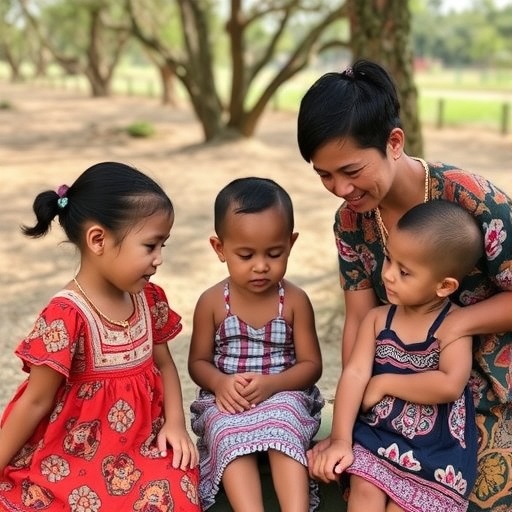The Marurra-U Partnership showcases a groundbreaking model of care that addresses the intricate needs of Aboriginal children in the remote Fitzroy Valley, Australia. As the complexities of child health continue to challenge communities in underserved regions, innovative approaches such as this partnership are pivotal. This initiative is designed to provide multidisciplinary care, drawing upon the expertise of various health professionals to support children facing numerous health issues intertwined with socio-economic challenges.
The term “hybrid model” specifically references the integrated approach that combines healthcare, social services, and educational support. By doing so, the Marurra-U Partnership aims to create a comprehensive support system that not only addresses immediate medical concerns but also acknowledges the broader determinants of health. Such an approach is essential in a landscape where traditional healthcare methods may fall short, especially for Indigenous communities that have unique cultural and contextual needs.
In establishing the framework of the Marurra-U Partnership, careful consideration was given to the historical context of Aboriginal peoples in Australia. Generations of marginalization and systemic barriers have led to considerable health disparities. Consequently, the initiative emphasizes cultural competency, promoting an understanding of Indigenous health practices and the integration of cultural traditions in the care provided to children and their families. This acknowledgment fosters trust and participation from the community, essential components for any health intervention to succeed.
At the heart of this initiative lies the recognition that complex needs often require input from multiple sectors. The multidisciplinary nature of the Marurra-U model means that various professionals—from pediatricians and psychiatrists to social workers and educators—collaborate in concert. Such collective efforts ensure that every aspect of a child’s well-being is accounted for, whether it involves mental health services, nutritional guidance, or educational support. This teamwork reflects a profound shift from singular treatment approaches towards holistic care frameworks.
Equally important is the wraparound component of the Marurra-U Partnership. This service delivery system is designed to envelop children and families with continuous support. The projected longitudinal benefits of this wraparound model are significant. By maintaining consistent or long-term engagement with health services, families are more likely to remain connected, reducing the chances of various health complications that can arise from intermittent care. Ensuring continuity of care is crucial in improving health outcomes for children who encounter barriers in accessing timely and appropriate services.
Moreover, the partnership diligently focuses on community engagement. Understanding and involving local leaders, families, and community members in the design and implementation of health programs forge a more robust connection between the services offered and the needs identified by the community itself. Community engagement serves as a cornerstone for building ownership and accountability, encouraging locals to take an active role in their children’s health and development.
Research conducted within this partnership lends further credence to the effectiveness of the implemented model. Preliminary findings suggest that children receiving care within this multidisciplinary framework exhibit improved health outcomes, greater family satisfaction, and enhanced overall quality of life. The thorough data collection and analysis are ongoing, with efforts aimed at measuring both immediate and long-term impacts on the cohort of children served through the partnership.
Collaboration extends beyond local boundaries, as experts and organizations from various backgrounds unite to create a shared vision for child health. The Marurra-U Partnership embodies an opportunity for knowledge exchange and resource sharing that transcends geographic limitations. By aligning with academic institutions and research centers, the partnership enriches its foundation with evidence-based practices, ensuring that care methodologies are effective and responsive to the community’s evolving needs.
Additionally, the role of technology in the delivery of care cannot be understated. The use of telehealth innovations allows for increased access to specialized services that may be otherwise unavailable in remote settings. Digital platforms can facilitate real-time consultations and interventions, bridging the gap between families and healthcare professionals. These advancements not only enhance the delivery of medical care but also empower families by providing them with valuable health information and resources.
The partnership dovetails with larger systemic changes in healthcare policy, advocating for reforms that address the social determinants of health impacting Aboriginal communities. Enhancing healthcare access, improving educational outcomes, and advocating for economic opportunities are all integral to ensuring that children not only survive but thrive. Engaging policymakers in dialogue around these pressing issues is vital for paving the way toward sustainable health improvements.
As the Marurra-U Partnership continues to evolve, it sets an inspiring example for other regions grappling with similar challenges. By demonstrating that success lies in collaboration, cultural understanding, and integrative care models, this initiative provides a promising blueprint for enhancing health services for all children, particularly those facing complex needs. The journey toward better health outcomes is long, but with persistent efforts, informed interventions, and a dedicated community, meaningful change is attainable.
This initiative exemplifies the profound impact of multidisciplinary care and community involvement in fostering holistic health solutions. As other regions look to form their own models, the principles established by the Marurra-U Partnership offer a path forward that prioritizes equity, empathy, and comprehensive care for the most vulnerable populations. By centering children’s needs within the fabric of care delivery, the Marurra-U Partnership is not only improving lives today but is also laying the groundwork for healthier generations to come.
In conclusion, the significance of the Marurra-U Partnership goes beyond its immediate outputs. It heralds a transformative approach to healthcare in Indigenous communities, showcasing that when healthcare systems align with cultural insights and multidisciplinary collaboration, the results can indeed be life-changing. Embracing this model does not just reflect a change in practice; it signifies a movement towards justice, equity, and comprehensive well-being for all children.
Subject of Research:
Article Title:
Article References:
Stubbs, T., Pickard, A., Carter, E. et al. The Marurra-U Partnership: providing a hybrid, multidisciplinary, wraparound model of care for Aboriginal children living with complex needs in the remote Fitzroy Valley, Australia.
BMC Health Serv Res 25, 1309 (2025). https://doi.org/10.1186/s12913-025-13258-8
Image Credits: AI Generated
DOI:
Keywords:




